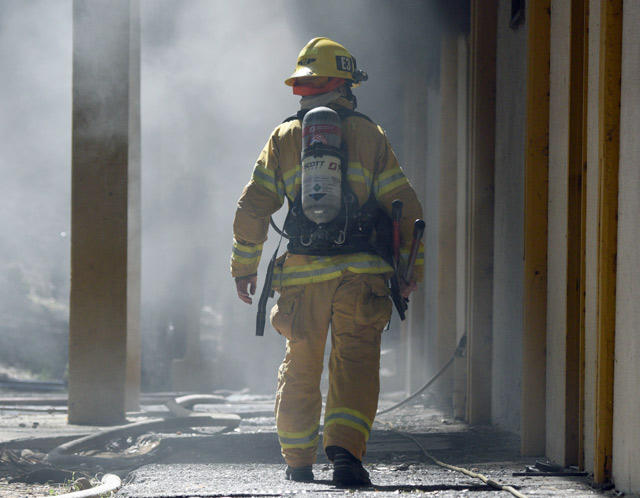Firefighters Battling Cancer, PTSD
New Studies Show They're Dying at Alarming Rates

Firefighters face even deadlier risks than burning homes and flaming hillsides — cancer and post-traumatic stress disorder (PTSD) are killing them at alarming rates, new studies show. According to the International Association of Fire Fighters (IAFF), which hosted its annual summit this week in Las Vegas, attended by Captain Tony Pighetti and Engineer Kevin Corbett with Santa Barbara City Fire, cancer is the leading cause of line-of-duty deaths in the United States — about 60 percent of career firefighters will die this way, “with their boots off,” as they call it. The rising number of casualties has been linked to noxious smoke from modern homes — newer furniture is routinely made with plastics, foams, and coatings laden with chemicals like benzene, formaldehyde, and hydrogen cyanide — and prolonged exposure to wildland fires for days at a time.
“There are just a plethora of toxic things that kill firefighters,” said Corbett, who was diagnosed with testicular cancer in March 2014 and was out for 18 months. He’s now back to full duty. He said he’s aware of four other current and retired City Fire members with cancer and counts himself lucky to have survived. “I’m in a very exclusive club and don’t want any more members.”
Smoke exposure is a recognized hazard of the job, Corbett said, but for many years the risks weren’t well understood or even talked about — guys wore their uniform pants thick with toxic chemicals around the station, and diesel-burning fire engines often idled in their closed bays. City Fire has discontinued both practices, said Corbett, and has taken a proactive approach to the issue. But more study is needed, he went on, and the IAFF is pushing for additional funding into research and outreach. Last spring, Congress introduced a bill to create a national registry of firefighters with cancer.
Like combat veterans, firefighters — in addition to police, paramedics, and dispatchers — are susceptible to the effects of post-traumatic stress, said Pighetti. Repeated exposure to death and violence can weigh heavily on the mind, which may lead to anxiety, depression, drinking, or drug abuse. Pighetti said fatal car accidents, like the triple-fatality on Cliff Drive last week, are especially hard. The IAFF estimates around 20 percent of firefighters and paramedics struggle with PTSD; a 2015 Florida State University study revealed 46.8 percent of the 4,300 firefighters surveyed thought about suicide, and 15.5 percent had attempted it.
“I know people in the department struggling with [PTSD],” said Pighetti. “It’s so hard to help.” In the past, firefighters would come back from a difficult call and not talk about it, he explained. They would sleep it off and then go to the next one. Now, departments like Santa Barbara’s are encouraging more dialogue and training its firefighters to notice signs of post-traumatic stress in one another. Pighetti said he and others are also looking to create a regional support group among first responders throughout the county; it’s much more effective to speak with someone who understands the job and its troubles than a therapist with no relatable experience, he said. All their efforts are aimed at one thing, said Pighetti: “We want to help prevent every unnecessary death.”



